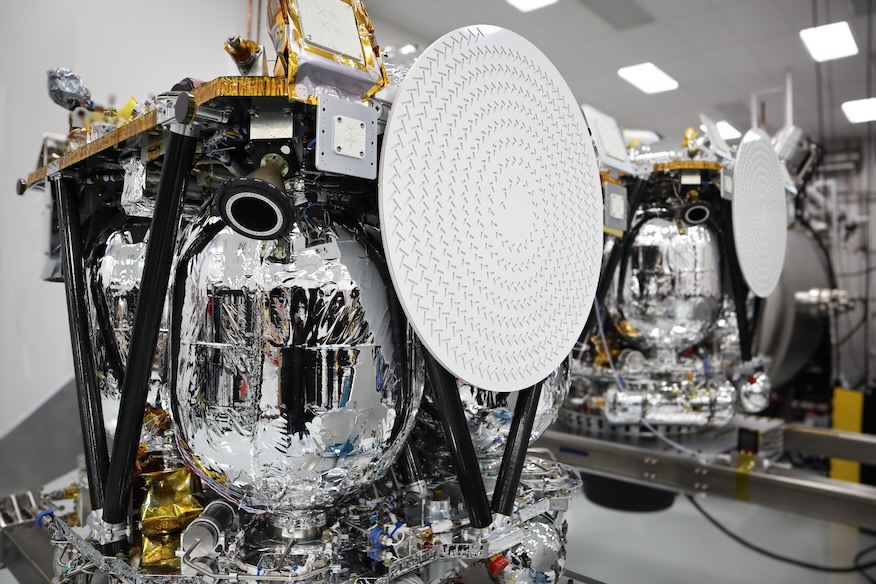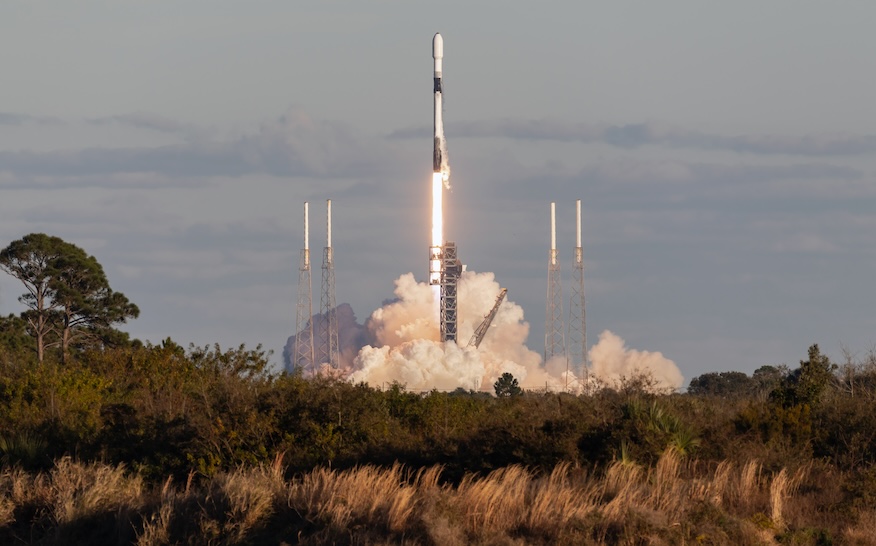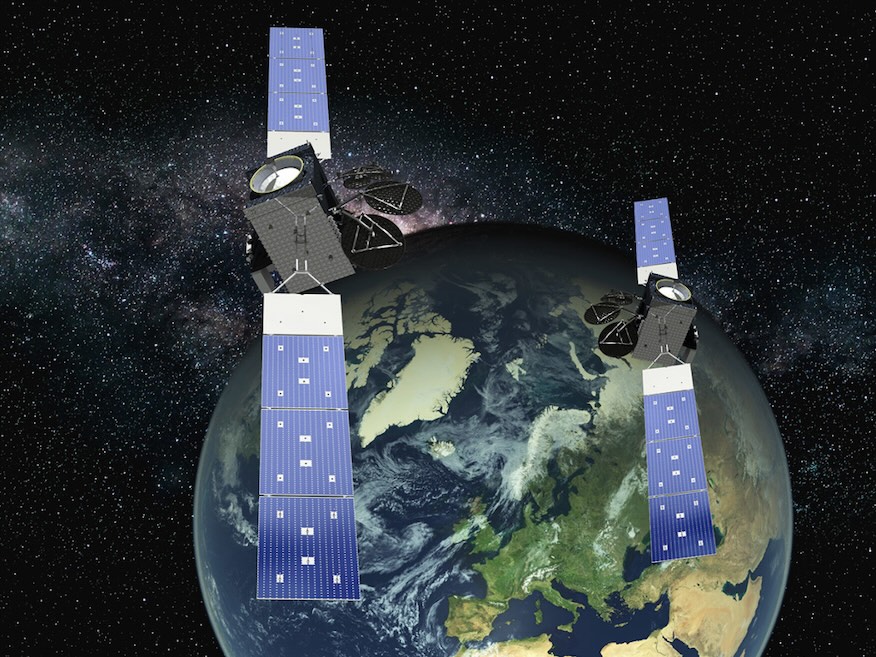
Rocket Lab is gearing up for its first mission to another planet. In the fall, two of its spacecraft will hitch a ride onboard a Blue Origin New Glenn rocket to begin their 11-month trek to Mars.
But before that happens, the twin spacecraft – named Blue and Gold – left Rocket Lab’s spacecraft manufacturing facility in Long Beach, California, and hit the road on Thursday to begin the journey to Florida’s Space Coast.
The duo will support NASA’s Escape and Plasma Acceleration and Dynamics Explorers (EscaPADE) mission, which the agency describes as the “first multi-spacecraft orbital science mission to the Red Planet.” The mission is set to launch no earlier than September 2024 on the inaugural New Glenn flight.
Last week, Christophe Mandy, the lead systems engineer on EscaPADE, led a media tour of the Long Beach site, showing off different parts of the space and the satellites themselves. He noted that the University of California, Berkeley’s Space Science Lab (SSL) is responsible for the science payloads onboard.

“It is being built by a lab that primarily does heliophysics. So, they study the interactions between what the Sun does and the rest of the solar system,” Mandy said. “In this specific case, they want to look at the interactions between the solar wind and the Martian atmosphere.
“They are looking for two different things. They’re looking for a phenomenon called ‘sputtering,’ which is where you have the billiard ball effect of a particle coming from the Sun, hitting a particle that’s at Mars and it goes away. The other type of interaction is called ‘ion escape,’ which is where that particle from the Sun comes and has a field, an electric field, typically. The electric field then steals an electric field on another particle, which then gets kicked off.”
Mandy said learning more about these effects will give scientists a better understanding of how the Martian atmosphere possibly evolved over time to make it uninhabitable and incapable of sustaining liquid water on its surface. It picks up the mission begun by NASA’s MAVEN (Mars Atmosphere and Volatile EvolutioN) mission, which launched back in 2013, but consisted of just one spacecraft.
Each of the EscaPADE spacecraft will use a suite of three main science instruments to search for these answers during their 11-month science mission:
- EMAG (Escapade MAGnetometer)
- EESA (Escapade ElectroStatic Analyzers)
- ELP (Escapade Langmuir Probe)

Building and budgeting for Mars
The EscaPADE satellites are being built as a part of NASA’s SIMPLEx (Small, Innovative Missions for PLanetary Exploration) program. The mission was selected by NASA in 2019 along with two other missions, each of which were given a cap of $55 million. For contrast, the MAVEN mission cost $671 million.
Originally, Mandy said the contract for the satellites went to a company called Tyvak International and the mission was manifested as part of NASA’s Psyche mission. That changed in 2020 when the agency decided to switch the Psyche mission from the expendable version of a Falcon 9 rocket to a Falcon Heavy, which ultimately changed that mission’s trajectory, according to Space News.
“This trajectory is not optimal for a mission with the goal of Mars capture and orbit, as EscaPADE is required to do, and would have required EscaPADE into an extended cruise phase to get into its correct orbit,” a NASA spokesperson told Space News at the time.
That meant that EscaPADE was de-manifested from the Psyche mission and NASA began searching for another launch option. Meanwhile, U.C. Berkeley was given an additional $1.8 million and nine more months to redesign the mission to be as flexible as possible in terms of launch vehicle options.
The University awarded a contract to build the spacecraft to Rocket Lab in November 2020 and in August 2021, a target launch date was set for October 2024.
“The payload on this spacecraft, the instrument set, is eight kilos. The entire spacecraft together is 525, so we’re sending 516 kilos of other stuff in order to get the eight kilos to Mars and that’s primarily because it’s really difficult to get from Earth orbit to Mars,” Mandy said. “The reason we’re going from Earth orbit to Mars is because we wanted to allow NASA to have as wide a range of possible launch options. Which, by the way, I think is a very cool achievement.”
Because the mission had a goal of launching by 2024 to capitalize on the optimal planetary launch window, that didn’t leave Rocket Lab with much time to work.
“The typical timeline for a Mars mission is a decade. Big missions like [Mars Sample Return], MSR started in 2002, so it’s already been over two decades. That’s the normal pace for an interplanetary mission,” Mandy said. “We had three-and-a-half years for everything.”
Mandy said everything about the design and execution of the two spacecraft was meant to stay within their means for both budget and time. He said the goal was creating “uncompromising efficiency.”
“There’s really nothing on the satellite that’s extraneous or complicated or unneeded,” Mandy said. “We typically push the capabilities of the technical side in order to find some really good synergies.”
Mandy said Rocket Lab built the majority of these spacecraft, including most of the avionics boxes as well as the multi-layer insulation (MLI), the radios, the star trackers and the solar panels. He said the propellant tanks had the longest lead time for manufacturing and were the last pieces of the spacecraft to arrive, on July 8, 2024.
The science instruments from U.C. Berkeley sit on the tops of these two-deck spacecraft. The items that generate heat, like the avionics and the batteries, are on the top deck to be cooled. Meanwhile, the bottom deck has all the fluid lines and the propellant tanks, which needs to stay warm.
Mandy said the two-deck structure made of a carbon composite material allowed them to shift more of the mass available from the structure to the other components. He said that’s a big shift from typical industry models.
“The typical number that you give is the primary structure, the main structure, should be on the order of 20 to 25 percent of the mass of the spacecraft. When we do it our way, ours is 11 percent,” Mandy said. “Pushing composites to extremes allows us to do that.”

The basic structure for EscaPADE stems from Rocket Lab’s Explorer satellite bus. It’s one of four in its spacecraft product line, alongside Lightning, Pioneer and Photon. The selection of any given satellite bus is driven by the mission’s needed capabilities.
“The Explorer product line, which would include the mission we sent to the Moon on Capstone, or EscaPADE, have a very, very high mass fraction that is fuel. In the case of EscaPADE, it’s almost 70 percent, which is an enormous number,” Mandy said. “So, if you are the type of mission that needs a lot of delta-v, you’ll probably go for Explorer.”
The main propulsion engine is the S400-12 Biprop Thruster from Arianespace, which uses a combination of monomethylhydrazine (MMH) and dinitrogen tetroxide (NTO). Mandy said they weighed a number of factors when it came to choosing which components to build and which to procure, like the engines.
“We looked at all the different options for engines that could get us [to Mars]. Rocket Lab has its own engines. We are more interested in mission success than anything else,” Mandy said. “There are these high heritage, very stable, long-duration mission engines that came out of other companies and we just picked one of those.”
Journey to Mars
Once the spacecraft complete their journey to Florida, they still have a notable, metaphorical road ahead before they’re ready for launch. Mandy said Blue and Gold will go through 21 days worth of processing, which includes another complete performance test.
After that, he and his team will take off all of the ‘remove before flight’ covers that are protecting various pieces of the spacecraft. They also need to enable and disable a variety of plugs before they get into fueling the spacecraft.
“There are four nitrogen tanks on the bottom. Those are our attitude control system tanks. Those have to be filled with nitrogen,” Mandy said. “There are two pressure tanks at the top with helium and then there’s the actual fueling itself. And once all of that is done, we’re ready.”

The twin spacecraft will then be mated to the payload adapter for Blue Origin’s New Glenn rocket ahead of its inaugural launch. Mandy said it has been an interesting process to work with a new rocket.
“It’s a new launch vehicle, which meant that the set of requirements that they had wasn’t fully defined from the beginning. And it was a process for us to work with Blue Origin and NASA LSP (Launch Services Program) as well as the program side, so NASA, Goddard and Berkeley, in order to nail things down,” he said. “Once you’re a company that has launched many, many launch vehicles, then you’ve got those well-defined, fully specked out user’s guides and Blue Origin just doesn’t have one yet, but they’re going to get there.”
The spacecraft will take roughly 11 months post-launch to make the journey to Mars. There are about seven burns leading up to what Mandy said the most important point to reach in the mission: the Mars orbit insertion burn, which will last about 700 seconds.
“Aside from being the one, critical burn, it is definitely the pucker part because once you’ve made it through MOI, we’ve got spare mass and margin on everything across the board,” Mandy said. “And gravity [is] on your side.”




